“From Invisible to Visible: Impacts of Metadata in Communicative Data Visualization” was accepted to TVCG 2022
Authors: Alyxander Burns, Christiana Lee, Thai On, Cindy Xiong, Evan Peck, Narges Mahyar
You can find the paper here.
“From Invisible to Visible: Impacts of Metadata in Communicative Data Visualization” was accepted to TVCG 2022
Authors: Alyxander Burns, Christiana Lee, Thai On, Cindy Xiong, Evan Peck, Narges Mahyar
You can find the paper here.
“How Data Scientists Review the Scholarly Literature” was accepted to CHIIR 2023
Authors: Sheshera Mysore, Mahmood Jasim, Haoru Song, Sarah Akbar, Andre Kenneth Chase Randall, Narges Mahyar
You can find the paper here.
“CommunityBots: Creating and Evaluating A Multi-Agent Chatbot Platform for Public Input Elicitation” was accepted to CSCW 2023
Authors: Zhiqiu Jiang, Mashrur Rashik, Kunjal Panchal, Mahmood Jasim, Ali Sarvghad, Pari Riahi, Erica DeWitt, Fey Thurber, Narges Mahyar.
You can find the paper here.
“Mapping Instability: The Effects of the Pandemic on the Civic Life of a Small Town” was accepted to the Environments By Design: Health, Wellbeing And Place Conference 2022
Authors: Erica Dewitt, Zhiqiu Jiang, Mashrur Rashik, Kunjal Panchal, Mahmood Jasim, Fey Thurber, Cami Quinteros, Ali Sarvghad, Narges Mahyar, and Pari Riahi
You can find the paper here.
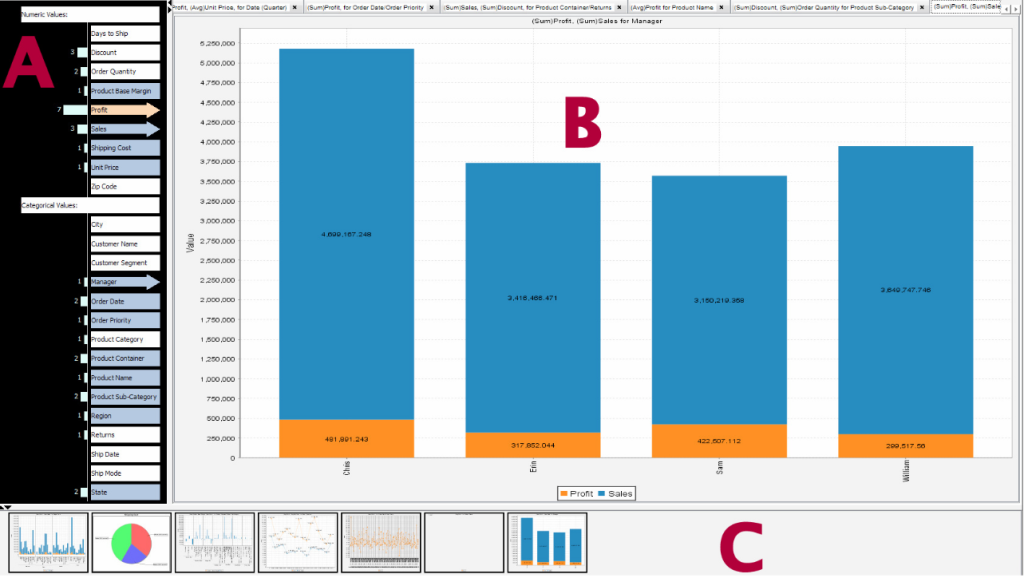
Led by: Ali Sarvghad, Melanie Tory, and Narges Mahyar
Related Links: “Visualizing Dimension Coverage to Support Exploratory Analysis”
“Visualizing Dimension Coverage to Support Exploratory Analysis”
Data analysis involves constantly formulating and testing new hypotheses and questions about data. When dealing with a new dataset, especially one with many dimensions, it can be cumbersome for the analyst to clearly remember which aspects of the data have been investigated (i.e., visually examined for patterns, trends, outliers etc.) and which combinations have not. Yet this information is critical to help the analyst formulate new questions that they have not already answered. We observe that for tabular data, questions are typically comprised of varying combinations of data dimensions (e.g., what are the trends of Sales and Profit for different Regions?). We propose representing analysis history from the angle of dimension coverage (i.e., which data dimensions have been investigated and in which combinations). We use scented widgets [30] to incorporate dimension coverage of the analysts’ past work into interaction widgets of a visualization tool. We demonstrate how this approach can assist analysts with the question formation process. Our approach extends the concept of scented widgets to reveal aspects of one’s own analysis history, and offers a different perspective on one’s past work than typical visualization history tools. Results of our empirical study showed that participants with access to embedded dimension coverage information relied on this information when formulating questions, asked more questions about the data, generated more top-level findings, and showed greater breadth of their analysis without sacrificing
depth.

Led by: Iman Deznabi, Tamanna Motahar, Ali Sarvghad, Madalina Fiterau, and Narges Mahyar
Related Links: “Impact of the COVID-19 Pandemic on the Academic Community Results from a survey conducted at University of Massachusetts Amherst”
“Impact of the COVID-19 Pandemic on the Academic Community Results from a survey conducted at University of Massachusetts Amherst”
The COVID-19 pandemic has significantly impacted academic life in the United States and beyond. To gain a better understanding of its impact on the academic community, we conducted a large-scale survey at the University of Massachusetts Amherst. We collected multifaceted data from students, staff, and faculty on several aspects of their lives, such as mental and physical health, productivity, and finances. All our respondents expressed mental and physical issues and concerns, such as increased stress and depression levels. Financial difficulties seem to have the most considerable toll on staff and undergraduate students, while productivity challenges were mostly expressed by faculty and graduate students. As universities face many important decisions with respect to mitigating the effects of this pandemic, we present our findings with the intent of shedding light on the challenges faced by various academic groups in the face of the pandemic, calling attention to the differences between groups. We also contribute a discussion highlighting how the results translate to policies for the effective and timely support of the categories of respondents who need them most. Finally, the survey itself, which includes conditional logic allowing for personalized questions, serves as a template for further data collection, facilitating a comparison of the impact on campuses across the United States.
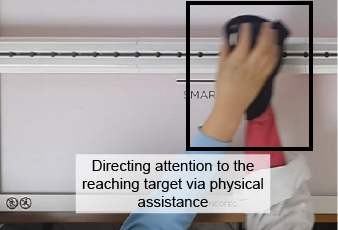
Led by: Hee-Tae Jung, Taiwoo Park, Narges Mahyar, Sungji Park, Taekyeong Ryu, Yangsoo Kim, and Sunghoon Ivan Lee
Related Links: “Rehabilitation Games in Real-World Clinical Settings: Practices, Challenges, and Opportunities”
“Rehabilitation Games in Real-World Clinical Settings: Practices, Challenges, and Opportunities”
Upper-limb impairments due to stroke can severely affect the quality of life in patients. Scientific evidence supports that repetitive rehabilitation exercises can improve motor ability in stroke patients. Rehabilitation games gained tremendous interest among researchers and clinicians because of their potential to make the seemingly mundane, enduring rehabilitation therapies more engaging. However, routine and longitudinal use of rehabilitation games in real-world clinical settings has not been investigated in depth. Particularly, we know little about current practices, challenges, and their potential impacts on therapeutic outcomes. To address this gap, we established a partnership with a rehabilitation hospital where game-assisted rehabilitation was routinely employed over a 2-year period. We then conducted an observational study, in which we observed 11 game-assisted therapy sessions and interviewed 15 therapists who moderated the therapy. Significant findings include (1) different engagement patterns of stroke patients in game-assisted therapy, (2) imperative roles of therapists in moderating games and challenges that therapists face during game-assisted therapy, and (3) lack of support for therapists in delivering patient-centered, personalized therapy to individual stroke patients. Furthermore, we discuss design implications for more effective rehabilitation game therapies that take into consideration both patients and therapists and their specific needs.
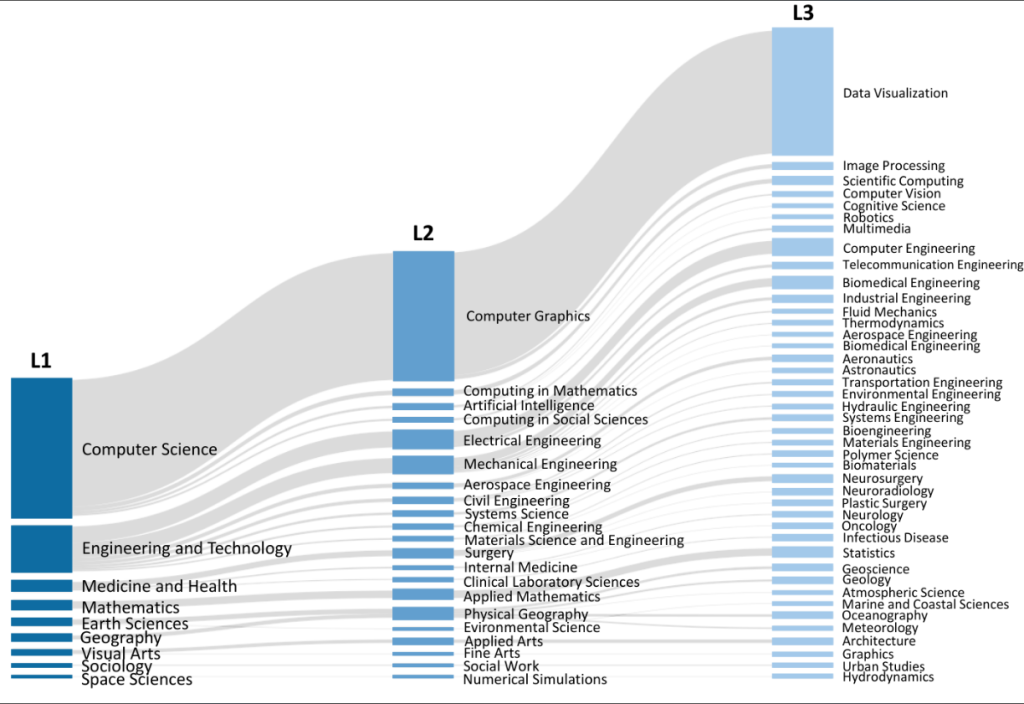
Led by: Ali Sarvghad, Narges Mahyar, Rolando Franqui-Nadal, Rebecca Reznik-Zellen, and Ria Chawla
Related Links: BiblioVis Dataset
BiblioVis Dataset
We performed a scientometric of 30 years of IEEE VIS publications between 1990-2020 in which we investigated the characteristics and trends of gender and collaboration among authors. We analyzed 3,302 publications and collected rich metadata about papers, authors, their affiliations, and institutions, as well as citation counts and references per paper. To derive authors’ genders, we used Gender API, which has been proven in prior research to have high accuracy in exploring gender trends. By using co-authorship as a proxy for collaboration, we investigated the degree and patterns of collaboration between institutions and disciplines. We characterized collaboration as interdisciplinary and inter-institutional and examined the relationship between collaboration trends and gender. Our analysis of the gender distribution shows a notable gap between men (5160, ~84.6\%) and women (899, ~14.7\%) authors. We discovered a steady growth in women authorship from 1990 (avg=3) to 2020 (avg=6). However, based on current trends, gender parity will not be reached sooner than 2062. Our analysis of co-authorship suggests a shift towards increased collaboration, with the average number of authors per paper at 3.7. We also found a steady growth in inter-institutional collaboration, with an average rate of 17.62 percent from 1990-2020, with the majority of inter-institutional collaborations between two institutions. Interdisciplinary collaborations were limited to only a few fields, including Computer Science, Engineering and Technology, and Medicine and Health disciplines. Our study contributes a multifaceted analysis, bringing to light the gender disparity in the current visualization research and providing paths for establishing a foundation for change. We also contribute a bibliometric dataset that complements the existing VisPub dataset by adding authors’ gender and discipline information. We hope our work will call attention to the critical issue of gender inequity within the VIS community and accelerate interdisciplinary to foster a more connected, collaborative, and inclusive community.
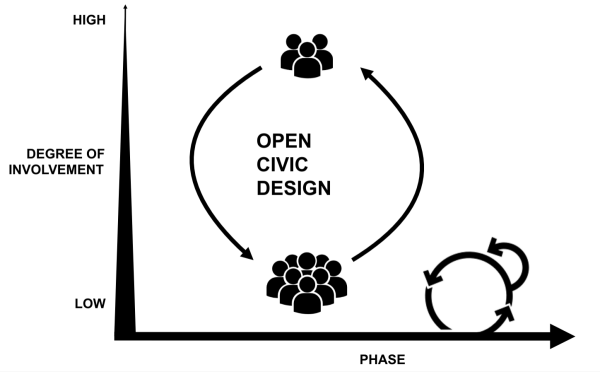
Led by: Brandon Reynante, Steven P. Dow, and Narges Mahyar
Related Papers: “A Framework for Open Civic Design: Integrating Public Participation, Crowdsourcing, and Design Thinking”
“A Framework for Open Civic Design: Integrating Public Participation, Crowdsourcing, and Design Thinking”
Civic problems are often too complex to solve through traditional top-down strategies. Various governments and civic initiatives have explored more community-driven strategies where citizens get involved with defining problems and innovating solutions. While certain people may feel more empowered, the public at large often does not have accessible, flexible, and meaningful ways to engage. Prior theoretical frameworks for public participation typically offer a one-size-fits-all model based on face-to-face engagement and fail to recognize the barriers faced by even the most engaged citizens. In this article, we explore a vision for open civic design where we integrate theoretical frameworks from public engagement, crowdsourcing, and design thinking to consider the role technology can play in lowering barriers to large-scale participation, scaffolding problem-solving activities, and providing flexible options that cater to individuals’ skills, availability, and interests. We describe our novel theoretical framework and analyze the key goals associated with this vision: (1) to promote inclusive and sustained participation in civics; (2) to facilitate effective management of large-scale participation; and (3) to provide a structured process for achieving effective solutions. We present case studies of existing civic design initiatives and discuss challenges, limitations, and future work related to operationalizing, implementing, and testing this framework.
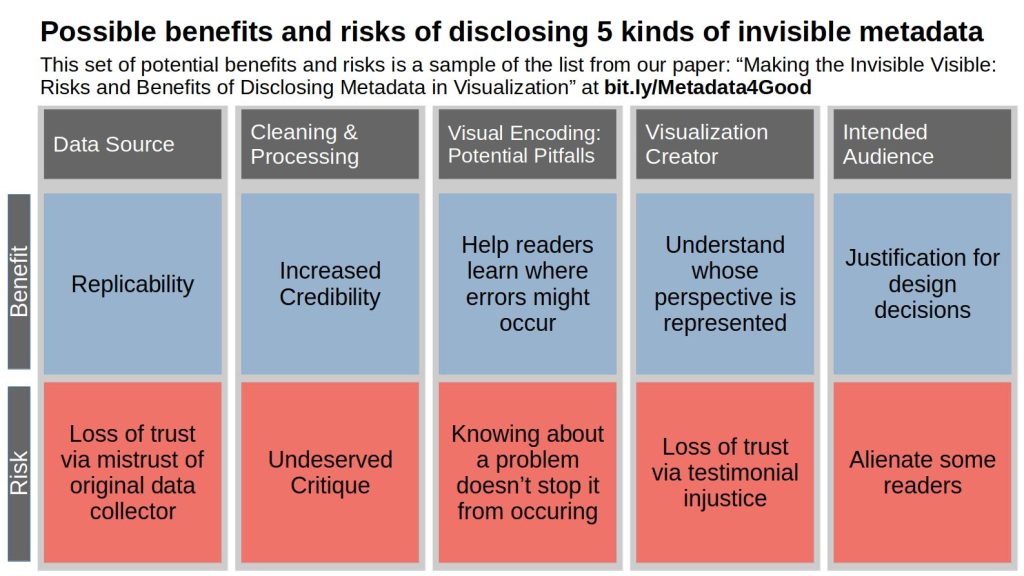
Led by: Alyxander Burns Making the Invisible Visible: Risks and Benefits of Disclosing Metadata in Visualization
Making the Invisible Visible: Risks and Benefits of Disclosing Metadata in Visualization![]() Talk
Talk
Accompanying a data visualization with metadata may benefit readers by facilitating content understanding, strengthening trust, and providing accountability. However, providing this kind of information may also have negative, unintended consequences, such as biasing readers’ interpretations, a loss of trust as a result of too much transparency, and the possibility of opening visualization creators with minoritized identities up to undeserved critique. To help future visualization researchers and practitioners decide what kinds of metadata to include, we discuss some of the potential benefits and risks of disclosing five kinds of metadata: metadata about the source of the underlying data; the cleaning and processing conducted; the marks, channels, and other design elements used; the people who directly created the visualization; and the people for whom the visualization was created. We conclude by proposing a few open research questions related to how to communicate metadata about visualizations.